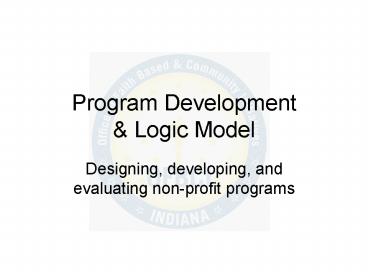Program Development PowerPoint PPT Presentation
1 / 13
Title: Program Development
1
Program Development Logic Model
- Designing, developing, and evaluating non-profit
programs
2
Program Development/Logic Model
- When developing a new program, it is especially
important that an organization address a few key
points when applying for funds to finance the
program. The following guidelines cover these
crucial steps, which include - Assessment of community needs
- Program design
- Performance measurement
- Program evaluation
3
Community Needs Assessment
- Before designing a program, it is recommended
that an organization conduct a community needs
assessment to determine that the program is
addressing a need that exists in the community.
In order to get an accurate picture, this
assessment should involve people representing
various aspects of the community. In gathering
research, the following questions may serve as a
guideline - Who does the problem affect? How many people are
affected? - How is this problem addressed in other locations
affected by it? What has and has not worked? - Is this problem already being addressed in this
community? How? - Continued
4
Community Needs Assessment Continued
- A new program should not be replicating services
already provided in the community. If the needs
assessment determines that the problem is already
being addressed adequately by other organizations
in the community, it may be best to narrow or
broaden the programs approach to address the
problem in a unique manner. - Visit other organizations addressing the problem,
in the community or not, to assess what
approaches do and do not work, and how services
can be improved upon.
5
Program Design
- Some basic qualities of a good program are that
it - Describes and gives evidence of a community need
that can be addressed. - Identifies a gap in services available in the
community which address the need. - Explains why this program is an appropriate
strategy to meet the need. - Outlines the activities of program members in
addressing the need. - Establishes community partnerships in the process
of addressing the community need. - Anticipates the positive outcome of the program
in the community. - Defines the method of measuring results (see the
following section on Performance Measurement).
6
The Logic Model
- A recommended method of program design is to use
a logic model to plan and evaluate the proposed
program. A logic model is a depiction of the
processes and targeted outcomes of the program.
This should help the organization to specify
goals, identify what resources are needed,
identify indicators of progress and measurements
of success, and communicate the programs
potential value.
7
The Logic Model Components
- The components of a basic logic model include
- Needs The community need as identified in the
Community Needs Assessment. - Inputs The resources needed to complete
activities. - Activities What staff, volunteers, etc. actually
do. - Outputs A measurement of the actual amount of
service completed. - Intermediate Outcomes Measurable change and
improvements in the programs constituents and/or
community. - End Outcomes The target changes that the
organization hopes to achieve in the programs
constituents and/or community.
8
Sample Logic Model
Need Inputs Activities Outputs Inter-mediate Outcomes End Outcomes
Low third-grade reading performance Staff Books Space Volunteers 20 volunteers will tutor children one-on-one in reading 3 times a week (x) number of children tutored Increased number of books read, increased reading on own Increased reading performance, improved grades
9
Performance Measurement
- The purpose of performance measures is to capture
the ongoing progress the program is making. It
should provide a snapshot of the impact of the
work that the organization is doing. This is an
especially important step in establishing
accountability to any funder. Identify all of the
services the organization provides and the likely
impact these services will have on the community.
10
Performance Measurement Tracking Tools
- Determine tracking tools for use in measuring the
results of services offered. These measures
should focus on goal outputs and outcomes, as
identified by the community needs assessment and
defined by the programs logic model. The
measures should be in quantifiable terms and
clearly defined. - A good guide for determining performance measures
is the acronym SMART. They should be - Specific
- Measurable
- Attainable
- Realistic
- Timely
11
Program Evaluation
- The program evaluation should be an analytical
study which measures the progress and impact the
program has made. Evaluations should be scheduled
and carried out throughout the course of the
program. This should consist of thorough and
objective research conducted by an experienced
evaluator, starting at the beginning of the
program year. Resources for finding a program
evaluator include colleges and universities,
research firms, and community organizations. The
evaluator should collect data relevant to the
programs activities and programs and evaluate
the organizations impact. - The organization should be consistently involved
in the evaluation process and should adjust the
programs offered according to performance
measures and program evaluations in order to best
serve the community.
12
Final Note
- Program development is a complicated process,
about which this resource offers only a brief
overview. For more information on program
development and the logic model, please refer to
the resources listed on the following slide.
13
Additional Resources
- CNCS Program Toolkit http//nationalserviceresour
ces.org/filemanager/download/online/sustainability
_toolkit.pdf - Logic Models http//www.uwex.edu/ces/pdande/evalu
ation/powerpt/nutritionconf05.ppt - Logic Model Development Guide http//www.wkkf.org
/Pubs/Tools/Evaluation/Pub3669.pdf - Logic Model - University of Idaho
http//www.uidaho.edu/extension/LogicModel.pdf

